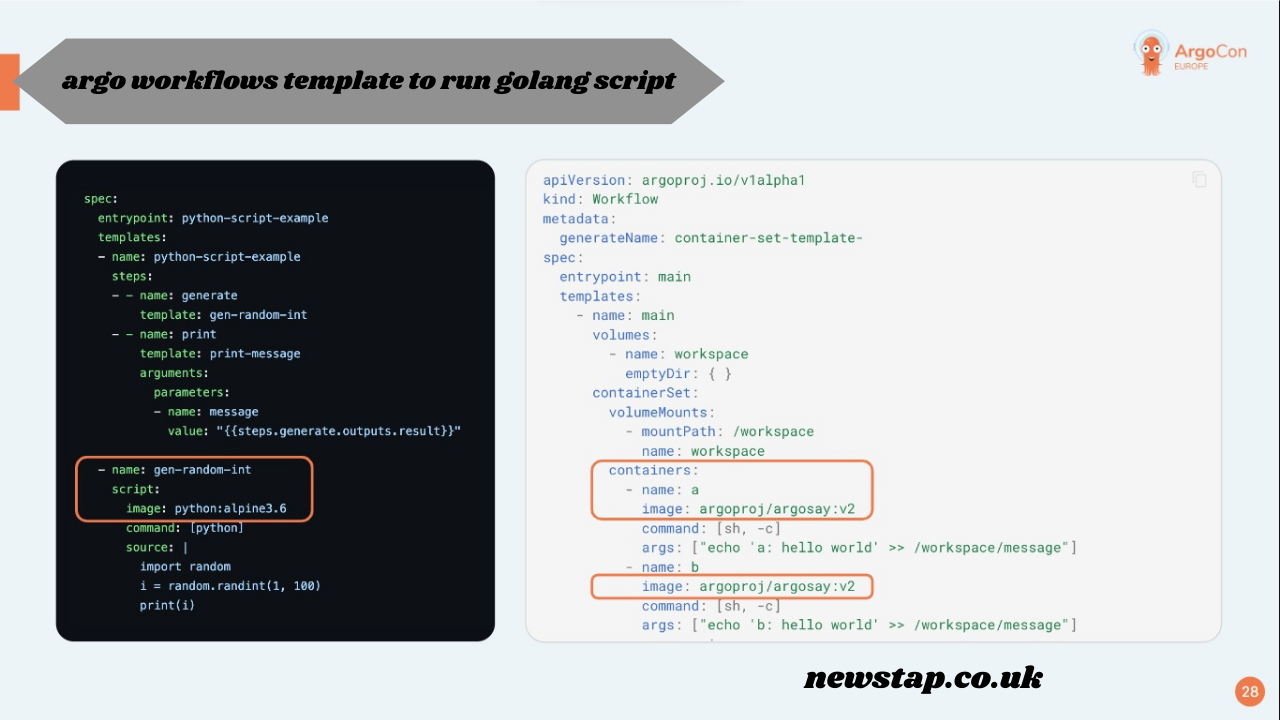Introduction
Argo Workflows is a powerful container-native workflow engine for orchestrating jobs on Kubernetes. It is widely used for automating complex workflows, including running Golang scripts in a controlled environment. In this guide, we will explore how to create an Argo Workflows template to run Golang script, covering everything from workflow definition to execution.
By leveraging Argo Workflows, you can efficiently execute Golang scripts inside Kubernetes pods, ensuring reproducibility, scalability, and automation. This article will provide a step-by-step approach to creating an Argo workflow to run Golang script seamlessly.
Understanding Argo Workflows
Before diving into running Golang code in Argo Workflow, let’s understand the basics of Argo Workflows.
Argo Workflows allows users to define workflows as YAML manifests, where each step is executed inside a Kubernetes pod. These workflows can be parameterized, parallelized, and integrated with various Kubernetes-native tools.
For running Golang scripts in Argo Workflow, we define a workflow template specifying the Golang container image, script execution commands, and dependencies.
Setting Up Argo Workflows
To use Argo Workflows, ensure you have the following prerequisites:
- A running Kubernetes cluster
- Argo Workflows installed (
kubectl apply -n argo -f https://github.com/argoproj/argo-workflows/releases/latest/download/install.yaml) - Argo CLI installed (
brew install argocdor via direct binary) - Docker installed for containerizing the Golang script
- A basic understanding of Kubernetes and YAML
Once Argo Workflows is installed, you can start defining templates to execute Golang scripts.
Creating an Argo Workflow to Run Golang Script
Step 1: Writing the Golang Script
First, create a simple Golang script named main.go that will be executed inside the Argo workflow.
package main
import (
"fmt"
)
func main() {
fmt.Println("Hello from Golang inside Argo Workflows!")
}Step 2: Dockerizing the Golang Script
To run Golang code in Argo Workflow, package it inside a Docker container.
Create a Dockerfile:
FROM golang:1.19
WORKDIR /app
COPY main.go .
RUN go build -o main main.go
CMD ["./main"]Build and push the image to a container registry:
docker build -t myrepo/golang-script:latest .
docker push myrepo/golang-script:latestStep 3: Defining the Argo Workflow Template
Now, define the Argo Workflows template to run Golang script using a YAML file:
apiVersion: argoproj.io/v1alpha1
kind: Workflow
metadata:
generateName: golang-script-workflow-
spec:
entrypoint: run-golang
templates:
- name: run-golang
container:
image: myrepo/golang-script:latest
command: ["/app/main"]Step 4: Submitting the Workflow
Apply the workflow to your Kubernetes cluster:
kubectl apply -f golang-workflow.yamlTo check the status of the workflow, run:
argo list
argo get <workflow-name>Step 5: Viewing Workflow Logs
Once the workflow completes, view logs using:
argo logs <workflow-name>This will display the output generated by the Golang script.
Customizing the Argo Workflow
To make the workflow more dynamic, you can:
- Add Parameters: Pass dynamic arguments to the Golang script.
- Use Secrets: Store sensitive data securely in Kubernetes secrets.
- Parallel Execution: Run multiple Golang scripts in parallel by modifying the workflow structure.
Example with parameters:
apiVersion: argoproj.io/v1alpha1
kind: Workflow
metadata:
generateName: golang-script-workflow-
spec:
entrypoint: run-golang
arguments:
parameters:
- name: message
value: "Hello from Argo!"
templates:
- name: run-golang
container:
image: myrepo/golang-script:latest
command: ["/app/main"]
args: ["{{workflow.parameters.message}}"]Submit with:
argo submit golang-workflow.yaml -p message="Custom message from Argo"Benefits of Running Golang Code in Argo Workflow
- Scalability: Argo can manage multiple executions efficiently.
- Automation: Workflows can be scheduled and triggered via external events.
- Reproducibility: The same workflow can be rerun with the same environment.
- Flexibility: Supports integration with CI/CD pipelines, Kubernetes, and cloud services.
Conclusion
Argo Workflows provides an efficient way to run Golang code in Argo Workflow by leveraging Kubernetes. By creating a workflow template, Dockerizing the Golang script, and executing it through Argo, you can automate and scale your Golang-based applications effortlessly.
This guide covered the step-by-step process to create an Argo workflow to run Golang script, including defining the YAML manifest, using Docker images, and executing workflows in Kubernetes. Now, you can integrate this approach into your projects and leverage Argo Workflows for efficient automation.



